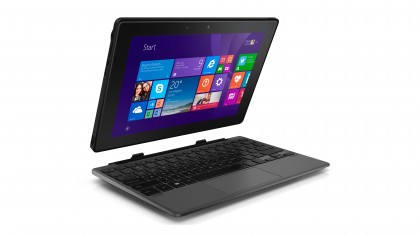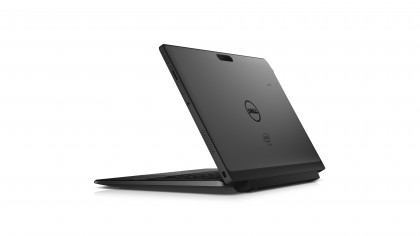Early Verdict
Although the Dell Venue 10 and Venue 10 Pro are competitively priced for education budgets, these tablets come with features that beat the Venue 11 Pro. A more precise Wacom digitizer, lighter keyboard dock, and performance to match the business-class Venue 11 Pro make the smaller series an attractive buy.
Pros
- +
Windows or Android options
- +
Wacom digitizer
- +
Performance
Cons
- -
1080p display optional
- -
Keyboard not standard
- -
Plastic construction
Why you can trust TechRadar
Dell is taking the success of the business-centric $700 (£437 or AU$800) Venue 11 Pro to the educational market in the form of the $299 (£197 or AU$390) Android-powered Dell Venue 10 and the $329 (£216 or AU$430) Windows-based Venue 10 Pro. Like the Venue 11 Pro, both Venue 10 tablets can be converted into a notebook thanks to an optional keyboard dock accessory.
With a new Wacom pen and optional keyboard docks, the Dell Venue 10 and Venue 10 Pro will compete in the same space as the $549(£356 or AU$708) Galaxy Note 10.1 2014 Edition, the larger 12-inch Surface Pro 3 at $799 (£519 or AU$1030), and also against smaller convertibles like the $749 (£486 or AU$966) 11.6-inch Lenovo Yoga 3. Apple's $499 (£324 or AU$644) 9.7-inch iPad Air 2 is also a strong competitor in the educational space.
And despite being based off of the same concept as the Venue 11 Pro, the less expensive Venue 10 series for education comes out ahead of its business counterpart in a few different ways.
Design
The design feels nicer in the hands than the Venue 11 Pro. Dell has replaced the soft-touch coating on the rear of the Venue 11 Pro, a feature that quickly accumulated dirt and grease in daily use, for a matte plastic finish. This makes the Venue 10 somewhat fingerprint and stain resistant, so it will feel and look nicer after a full day of use

Despite its plastic construction, the 1.6-pound (723g) Venue 10 Pro is designed to be a durable device. Like the $299 (£194 or AU$386) Latitude 11 and the $249.99 (£164, AU$327) Chromebook 11 in this year's education portfolio, the Venue 10 series comes with rubberized side bumpers to help protect it against small drops.
The bumpers also serve a second purpose in helping to provide a little bit of grip as the device doesn't come with the soft-touch material that debuted on the larger Venue 11 Pro.
The downside to Dell's design decision is that you're left with a mostly plastic construction. Compared to the aluminum-clad iPad Air 2 or the faux leather bound Galaxy Note 10.1 2014 Edition, the Venue 10 series feels more like a budget offering. Yet, despite being made of plastic, the Venue 10 weighs significantly more than the 0.96-pound (437g) iPad Air 2.
Made to be portable, the 11.01 X 0.42 X 6.95-inch (279.8 X 10.75 X 176.4 mm) Venue 10 has a 10-hour battery life, enabling a full academic day of use without having to recharge. An optional Mobile Computing Cart allows teachers to charge and secure up to 30 tablets overnight.
Digital inking
Both Venue 10 tablets now use a Wacom digitizer, a first for the Venue series. This is a departure from the Synaptics-based stylus found on the Venue 8 Pro and Venue 11 Pro, and Dell claims the switch to Wacom helps improve inking accuracy.

This is important in math and science classes where students may need to draw detailed diagrams, formulas, or mathematical equations. And unlike the Synaptics pen, students won't have to worry about replacing batteries in the Wacom pen.
Performance
Both tablets feature a 10.1-inch HD display and Intel's powerful fifth-generation Core M processor, more commonly known as Broadwell. Also found on the more expensive Venue 11 Pro, the Core M processor delivers excellent performance, a fan-less design, and improved graphics thanks to the newer Intel HD Graphics 5300 architecture.
With the Core M processor, the Venue 10 series delivers Ultrabook-like performance, especially when paired with the optional keyboard dock.
Despite its compact size, the keyboard dock provides for full-sized keys, but with reduced key spacing. I found the keyboard to be comfortable, and I quickly adjusted to the reduced key spacing. The keyboard also offers decent key travel for a responsive typing experience.
Unlike the Venue 11 Pro's optional keyboard dock, the Venue 10 keyboard does not come with a second battery to extend usage of the tablet in laptop mode. The benefit to not having a secondary battery in the dock makes the Venue 10 a lot lighter with the dock.
Dell says the keyboard for the Venue 10 ($349 with keyboard, or £229 or AU$456) will not be interchangeable with the keyboard for the Venue 10 Pro ($379 with keynoard, or £249 or AU$495), so you won't be able to mix and match your tablets and keyboards.
In the classroom
Another difference with the Dell Venue 10 series and the Venue Pro 11 is that the keyboard dock provides for more versatility with more use modes.
Now, you can either dock the Venue 10 series with the screen facing the keyboard, for use in laptop mode, or away from the keyboard in display mode. In display mode, when you close the tablet down onto the keyboard, you can use the Venue 10 series as a tablet and also have the keyboard attached so you won't lose it or forget one component.
With optional NFC, teachers can have a fully digital classroom and distribute classroom handouts by tapping two tablets together. Additionally, with wireless projectors, students can share their content with the class easily.
The Venue 10 will be one of the first Android Lollipop devices certified for education when it launches this spring. The tablet will have access to the Google Play for Education store while the Venue 10 Pro will ship with Windows 8.1 National Academic on March 3.
Flaws
To keep the price down on both tablet models, some features are not standard on the Venue 10 series.
Dell says that the resolution on the screen is 1280 X 800 pixels. For those who prefer a full HD display, a consumer option will be available.
Another issue with the screen is that it feels cramped for multitasking. Having a small screen may be fine for students in lower grade levels who need to open one app at a time, but those in advanced grades will likely need to keep multiple windows open simultaneously. Students who need to pull up a webpage to do research while typing a report in another window may feel like they need to juggle between windows.
lthough the Wacom digital pen is a welcome upgrade I can foresee the pen being a costly replacement for schools and students if it is broken or lost.
For students who may have after-school tutoring or extended school days, the lack of a keyboard dock option with a secondary battery could mean that the Venue 10 will need to be plugged in during the day.
Early verdict
With the Venue 10 series, Dell shows that tablets aimed at the academic market do not have to be clunky. The Venue 10 and Venue 10 Pro build off of the elegant design of the business-class Venue 11 Pro series, and Dell made a few adjustments to make these tablets stand up to the rigors of daily student use. The addition of rubberized bumpers and a switch to the more precise Wacom pen for inking make the Venue 10 series a perfect companion for the classroom.
With the Core M processor, the Venue 10 packs as much performance as the $700 (£460 or AU$914) Venue 11 Pro, but at a much lower starting price provided you can live with a smaller 10.1-inch screen.

With the optional keyboard dock, the Venue 10 Pro feels a lot lighter than the Venue 11 Pro, making it easier to travel with. Additionally, the tablet can be docked with the screen facing in or out, adding more use modes. You can use the tablet in display mode, tent mode, laptop mode, or even docked into the keyboard as a tablet so you won't forget or lose the keyboard when you're not using it for typing.
The Venue 10 and Venue 10 Pro offer a lot of versatility at a great price point. Given its performance and price, both tablets will appeal to a broader consumer market outside of the education segment.
Despite its compact size with a 10.1-inch display, the keyboard dock provides for full-sized keys, but with reduced key spacing. In our hands on with the package, we found that the keyboard was comfortable to type on with decent key travel for a responsive typing experience.
Unlike the Venue 11 Pro's optional keyboard dock, the Venue 10 keyboard does not come with a second battery to extend usage of the tablet in laptop mode. The benefit to not having a secondary battery in the dock makes the Venue 10 a lot lighter with the dock.
Dell tells TechRadar Pro that the keyboard for the Venue 10 will not be interchangeable with the keyboard for the Venue 10 Pro, so you won't be able to mix and match your tablets and keyboards.
Another difference with the Dell Venue 10 series and the Venue Pro 11 is that the keyboard dock provides for more versatility with more use modes.
Now, you can either dock the Venue 10 series with the screen facing the keyboard, for use in laptop mode, or away from the keyboard in display mode. In display mode, when you close the tablet down onto the keyboard, you can use the Venue 10 series as a tablet and also have the keyboard attached so you won't lose it or forget one component.
What is a hands on review?
Hands on reviews' are a journalist's first impressions of a piece of kit based on spending some time with it. It may be just a few moments, or a few hours. The important thing is we have been able to play with it ourselves and can give you some sense of what it's like to use, even if it's only an embryonic view. For more information, see TechRadar's Reviews Guarantee.
